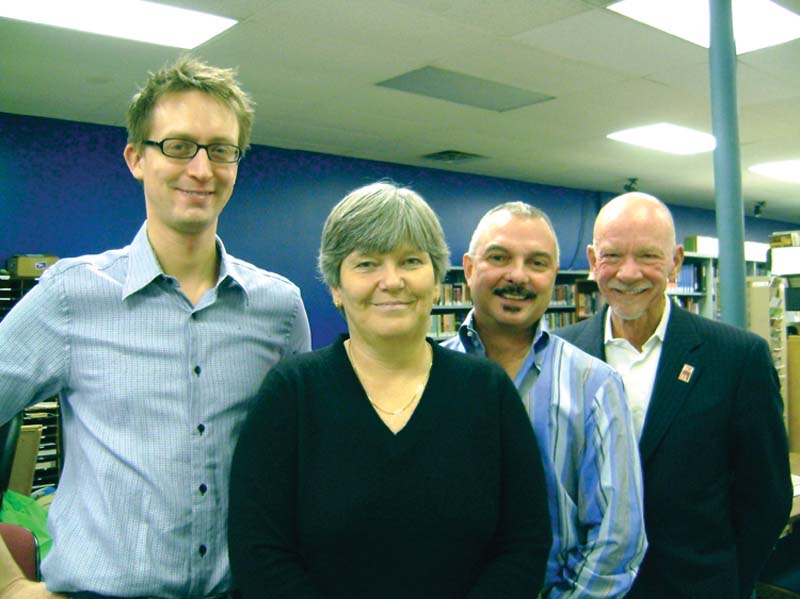The Chicago Ordinance on Human Rights, which banned discrimination against gays and lesbians and other minorities, was passed on December 21, 1988. Gerber/Hart Library, 1127 W. Granville, recently organized a panel discussion to mark the occasion.

Timothy Stewart-Winter, who presented a slide show presentation about the organizing leading to the passage of the ordinance, moderated the Nov. 9 discussion. Other speakers included three gay activists who had been among those instrumental in getting the ordinance passed. Laurie Dittman, Rick Garcia, Arthur (Art) Johnston and Jon-Henri Damski (now deceased) were once considered so powerful in the gay community that the Chicago Tribunedubbed them the “Gang of Four.”
According to Stewart-Winter, the ordinance came about after 15 years of organizing by various gay activists prior to 1988. “The political framework for the ordinance was the Civil Rights Act of 1964, which prohibited job discrimination by race and sex, and which became a template for fundamental rights legislation at all levels of government,” he said. Original efforts to pass the ordinance began at least in 1971, when Chicago Gay Alliance (CGA), an outgrowth of the Gay Liberation movement, began its efforts. For instance, in 1972, Bill Kelley asked the State Fair Employment Practices Commission, on behalf of CGA, to ban discrimination in companies with state contracts.
In the mid-1980s, the “Gang of Four” began spearheading renewed efforts to pass the ordinance and saw it move through the City Council under a few different mayors, including Harold Washington, who died in office in 1987. The ordinance went through under the tenure of his replacement, Eugene Sawyer. Sawyer had once opposed the ordinance, but now supported because he felt it was part of Washington’s legacy.
Dittman, currently senior policy analyst for the Chicago Mayor’s Office for People with Disabilities, described how the activists of the late 1980s approached the ordinance in “very different” ways than in previous years. “When we became involved in the ordinance, there was a very different philosophy in the community, where the approach for passing legislation was really seeking the approval of the greater good and the general population. We [used] a much more targeted strategy. What we put together was not so much [about] changing the public opinion, but what was it that each alderman needed to support the ordinance.”
Garcia, political director of Equality Illinois, began by acknowledging the work of activists who’d worked on the ordinance prior to the “Gang of Four.” He said, “In my mind, it was a blessing for us to be at the point when we crossed over at the finish line. All we did [was] build on the great work of those who went before us, like Bill Kelley in 1972. The four of us could not have done it alone. We were looking to a new day and a new way to do things in Chicago politics.” Garcia emphasized that one of the first lessons they learnt was that winning a vote had less to do with “winning hearts and minds” and everything to do with gathering the requisite number of votes to pass a measure among the aldermen.
Johnston, co-owner of Sidetrack, pointed to the lessons learned from even the defeats. For instance, when the ordinance was defeated during Harold Washington’s brief tenure, “We [had] thought Washington would find the way [by garnering the votes in support].” (Washington faced enormous opposition from white aldermen, and Johnston spoke admiringly of him). The ordinance’s failure taught the activists “a critical lesson—you have to do it yourself.” He added that the contribution of the group was that it “brought a practical focus on where we had to go.”
William Kelley was among those in the audience whose name was evoked as one of the activists who initiated the push for the ordinance in the 1970s. Windy City Times spoke with Kelley about the generational shifts in strategy. He said that Stewart-Winter had done “a good job of outlining all the early work that went into the ordinance. And the panelists acknowledged the groundwork that had been laid earlier and pointed to a new set of tactics to get the ordinance passed.”
Kelley did point out that not all the strategies deployed in the ’80s were new and that “there had been efforts at generating ward by ward support from the aldermen as early as the ’70s. What was new was what the people who came out in the latter stages were much better organizers and their … synergy made this whole greater than the sum of its parts.” Cautioning against seeing history as a set of “new” moments with sharp divisions between before and after, Kelley said that “[h]istory is a continuum, with watershed moments.”